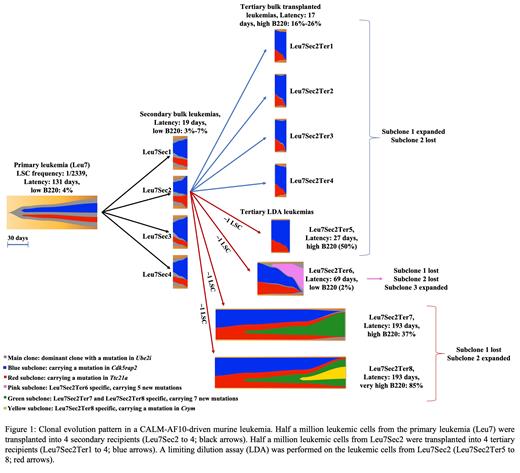Abstract
Myeloid leukemia is caused by acquired genetic changes in haematopoietic stem cells. The combination of stepwise acquisition of genetic changes together with selection of the fittest clones results in great genetic and clonal heterogeneity. We used a CALM-AF10-driven retroviral transduction murine bone marrow transplantation leukemia model (MBMTLM) to study clonal hierarchy and clonal evolution starting with a primary leukaemia (Fig 1: Leu7) which developed after 131 days and had B220 marker expression on 4% of its cells. Limiting dilution assays (LDAs) showed that the leukemia stem cell (LSC) frequency of Leu7 was 1:2339 (95% confidence interval: 1:794-1:6885). Whole exome sequencing (WES) and analysis of the variant allele fraction of somatic mutations revealed that Leu7 was composed of a main clone (Fig 1: grey) with two subclones (blue and red). Half a million leukemic cells from Leu7 were transplanted into 4 sublethally irradiated recipients, which all developed secondary leukemias after a latency of 19 days (Leu7Sec1 to 4). All secondary leukemias showed similar B220 expression levels to Leu7, and all showed an expansion of the blue subclone. When again half a million cells each of one of the secondary leukemias (Leu7Sec2) were transplanted into 4 recipients, the expansion of the blue subclone continued, the red subclone vanished and, surprisingly, the proportion of B220 expressing cells increased to between 16 to 26%. LDAs showed that the LSC frequency of Leu7Sec2 had not changed. However, several of the leukemias from the LDAs had greatly varying latencies (27 to 193 days) and B220 marker expression (2 to 85%). Four of these tertiary LDA leukemias (Leu7Sec2Ter5 to 8), which each arose from a single LSC, were analysed more closely using WES. Leu7Sec2Ter5 showed a similar latency (27 days) and B220 expression levels like Leu7SecTer1 to 4 and also had the expansion of the blue subclone. Leu7Sec2Ter6 had a long latency of 69 days and a very low B220 expression. Leu7Sec2Ter6 was driven by a new, third subclone (pink), and both the blue and the red subclone disappeared. Very interestingly, Leu7Sec2Ter7 and Leu7Sec2Ter8 had a very long latency of 193 days, and showed an expansion of a subclone (green) of the red subclone. The B220 expression was high (37%) to very high (85%) in these two leukemias.
Taken together, these observations paint an interesting picture with the blue subclone outcompeting the red subclone, as leukemias arising from the red subclone only appear after a long latency and in leukemias initiated by a single LSC, when there is no blue subclone LSC present. As the four leukemias (Leu7Sec2Ter5 to 8), which each were derived from a single LSC, showed striking differences in latency and surface marker expression, it can be concluded that this variation in phenotype is an intrinsic property of an individual LSCs most likely a consequence of the distinct combination of somatic mutations present in the individual LSCs. These observations also suggest that distinct LSCs with different properties might be present in a single human leukemia.
Browett: Janssen: Membership on an entity's Board of Directors or advisory committees; MSD: Membership on an entity's Board of Directors or advisory committees; AbbVie: Honoraria.


This feature is available to Subscribers Only
Sign In or Create an Account Close Modal